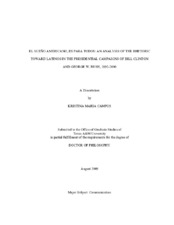| dc.description.abstract | This dissertation examined the presidential elections of 1992, 1996 and 2000 for
the narrative tools used to persuade Latino voters. Using Walt Fisher's narrative theory,
I evaluated the various parts of the American Dream myth, looking specifically at the
characters and settings used in the candidate's narrative. Then, I evaluated the values in
those narratives through the lens of the Plan of Delano, specifically looking for ways
these candidates actually reinforced important Latino values.
The new tellings of the American Dream myth valued specific characters-
characters that had been blessed by the American Dream. Clinton's 1992 character had
to work to gain success, but he was also blessed. George P. Bush (George W. Bush's
nephew) was another character blessed by the American Dream. As a first-generation
American, he represented the hope that brings many to America; the idea that their
children could have opportunities the parents could not. The settings of the American Dream story were also important. These settings
varied greatly-from the decrepit and desolate to the fanciful and idyllic-but they
represented all the different places where the American Dream is possible.
Hope, Arkansas is not a place where much hope seems to exist. But even a
community as impoverished as Hope can be the birthplace of a President, because of the
amazing ability of the Dream to permeate even the darkest corners of America. The
barrios of the Southwest appear to be hopeless, but as Clinton's telling of the myth
reminded Latinos, even people growing up in the barrios should have hope-because the
American Dream can exist anywhere.
These values, these characters, these settings have added to the rich rhetorical
history of the American Dream myth. These presidential candidates expanded the places
where that hope could reach, and the people who could be blessed by the Dream. All of
this culminated in a story that Latinos could relate to, that they shared in and that
rhetorically persuaded them to believe in these candidates. | en |


